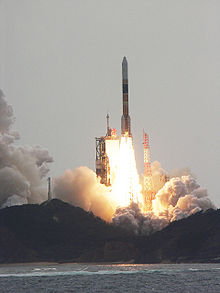Information Gathering Satellite
The Information Gathering Satellite (IGS, Japanese 情報 収集 衛星 , jōhō shūshū eisei ) are satellites of a Japanese spy satellite program . This series includes both optical and radar reconnaissance satellites.
history
The program was launched in response to the North Korean missile test of the Taepodong missile with a flight path towards Japan in 1998. Its main task is the early warning of missile launches in the vicinity of Japan. It should be noted, however, that Earth observation is a relatively new area for Japan. The first Japanese mission MOS-1 in this area did not take place until 1987. For this reason, Japan still lacks some technological details in the area with a resolution of one meter and less. The program is under the control of Naikaku Jōhō Chōsashitsu at the Cabinet Secretariat and is intended to provide both military and remote sensing data for natural disasters. Civil use matters because a Japanese law of 1969 regulates military space activities.
Japan invested about 250 billion yen prior to the initial launch for the development of the satellites and another 50 billion yen for the ground station. Each individual satellite costs about 50 billion yen. Operating costs are about 40 billion yen per year.
The satellites will be launched from the Yoshinobu launch site of the Tanegashima Space Center with an H-II-A rocket . The first pair of satellites, IGS-1A and IGS-1B, was launched on March 28, 2003. It was an 850 kg satellite working in the optical range with one meter resolution (1A) and a 1200 kg satellite working with radar with synthetic aperture (1B) with three meters resolution and a planned lifespan of five years each. The satellites, built by Mitsubishi Electric (MELCO), operated until March 2007. The program suffered a major setback when Japan lost the second pair of satellites due to an H-2A false start in November 2003. One of the two burned-out solid fuel boosters had not separated from the rocket. The additional weight prevented the H-II-A missile from reaching orbit. 11 minutes after take-off, it was blown up by remote control at a height of 422 km for safety reasons. IGS-3A was launched individually in September 2007. Another pair, IGS-4A and IGS-4B (sometimes also referred to as 3B because 3A was only launched individually), was carried out by an H-2A rocket from the Tanegashima Space Center in February 2007.
Start list
| Date ( UTC ) | satellite | COSPAR name | Launcher | Remarks | orbit |
|---|---|---|---|---|---|
| March 28, 2003 | IGS-1A and 1B | 2003-009A and 2003-009B | H-IIA 2024 | 1B failed on March 25, 2007 due to problems with its power supply | 500 km, inclination 97.3 ° |
| November 29, 2003 4:33 am |
IGS-2A and 2B | - | H-IIA 2024 | False start, rocket had to be blown up because the nozzle of the booster built by Nissan had burned out and a device required for booster separation was damaged. | - |
| September 11, 2006 4:35 am |
IGS-3A | 2006-037A | H-IIA 202 | optical satellite only | 484 × 491 km, inclination 97.3 ° |
| February 24, 2007 4:41 am |
IGS-4A (3V or 4V) and 4B | 2007-005A and 2007-005B | H-IIA 2024 | Radar satellite and optical test satellite (testing an improved version) | 481 km × 494 km, orbital time 94.4 min, inclination 97.2 ° |
| November 29, 2009 1:21 am |
IGS 5A | 2009-066A | H-IIA 202 | optical satellite | |
| September 23, 2011 4:36 am |
IGS 6 | 2011-050A | H-IIA 202 | optical satellite | |
| December 12, 2011 1:21 am |
IGS radar 3 | 2011-075A | H-IIA 202 | Radar satellite | |
| January 27, 2013 4:40 am |
IGS Radar 4 and IGS Optical 5V | 2013-002A and 2013-002B | H-IIA 202 | Radar satellite and test of a high resolution optical satellite | Inclination 97.4 ° |
| February 1, 2015 1:21 am |
IGS Radar Spare | 2015-004A | H-IIA 202 | Radar satellite | |
| March 26, 2015 1:21 am |
IGS Optical 5 | 2015-015A | H-IIA 202 | optical satellite | |
| March 17, 2017 1:20 am |
IGS Radar 5 | 2017-015A | H-IIA 202 | Radar satellite | |
| February 27, 2018 4:34 am |
IGS Optical 6 | 2018-021A | H-IIA 202 | optical satellite | |
| June 12, 2018 4:20 am |
IGS radar 6 | 2018-052A | H-IIA 202 | Radar satellite | 507.4 km × 508.8 km inclination: 97.4 ° orbit time: 94.6 min |
| February 9, 2020 1:34 am |
IGS Optical 7 | H-IIA 202 | optical satellite |
Web links
- Military Spacecraft - Japan on Gunter's Space Page (English)
- IGS in the Encyclopedia Astronautica (English)
- Federation of American Scientists: Information Gathering Satellites Imagery Intelligence (story in English)
Individual evidence
- ↑ Information Gathering Satellites. Federation of American Scientists, October 11, 2008, archived from the original December 13, 2009 ; accessed on October 17, 2009 .
- ↑ Stephen Clark, Justin Ray: Japanese launch fails. Spaceflight Now, November 29, 2003, accessed October 16, 2009 .
- ^ A b Jean-Philippe Donnio: Program: IGS. In: The Satellite Encyclopedia. Tag's Broadcasting Services, accessed November 28, 2009 .
- ↑ SPACEWARN Bulletin, No. 640. National Space Science Data Center / World Data Center for Satellite Information, March 1, 2007, accessed October 16, 2009 .
- ^ Gunter Krebs: IGS-Optical 5V. In: Gunter's Space Page. September 14, 2016, accessed January 25, 2017 .
- ↑ IGS R-6 Satellite details 2018-052A NORAD 43495. Retrieved June 20, 2018 (English).
